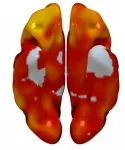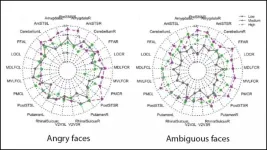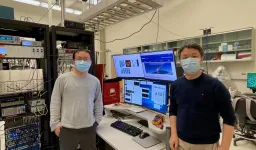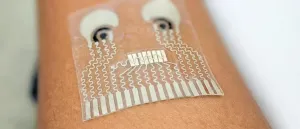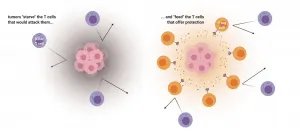Corn belt farmland has lost a third of its carbon-rich soil
UMass Amherst researchers used remote sensing to quantify the previously underestimated erosion
2021-02-15
(Press-News.org) More than one-third of the Corn Belt in the Midwest - nearly 100 million acres - has completely lost its carbon-rich topsoil, according to University of Massachusetts Amherst research that indicates the U.S. Department of Agricultural has significantly underestimated the true magnitude of farmland erosion.
In a paper published in the Proceedings of the National Academy of Sciences, researchers led by UMass Amherst graduate student Evan Thaler, along with professors Isaac Larsen and Qian Yu in the department of geosciences, developed a method using satellite imagery to map areas in agricultural fields in the Corn Belt of the Midwestern U.S. that have no remaining A-horizon soil. The A-horizon is the upper portion of the soil that is rich in organic matter, which is critical for plant growth because of its water and nutrient retention properties. The researchers then used high-resolution elevation data to extrapolate the satellite measurements across the Corn Belt and the true magnitude of erosion.
Productive agricultural soils are vital for producing food for a growing global population and for sustaining rural economies. However, degradation of soil quality by erosion reduces crop yields. Thaler and his colleagues estimate that erosion of the A-horizon has reduced corn and soybean yields by about 6%, leading to nearly $3 billion in annual economic losses for farmers across the Midwest.
The A-horizon has primarily been lost on hilltops and ridgelines, which indicates that tillage erosion - downslope movement of soil by repeated plowing - is a major driver of soil loss in the Midwest. Notably, tillage erosion is not included in national assessments of soil loss and the research highlights the urgent need to include tillage erosion in the soil erosion models that are used in the U.S. and to incentivize adoption of no-till farming methods.
Further, their research suggests erosion has removed nearly 1.5 petagrams of carbon from hillslopes. Restoration of organic carbon to the degraded soils by switching from intensive conventional agricultural practices to soil-regenerative practices, has potential to sequester carbon dioxide from the atmosphere while restoring soil productivity.
INFORMATION:
ELSE PRESS RELEASES FROM THIS DATE:
2021-02-15
The links between cardiovascular disease and cognitive impairment begin years before the appearance of the first clinical symptoms of either condition. In a study carried out at the Centro Nacional de Investigaciones Cardiovasculares (CNIC) in partnership with Santander Bank and neuroimaging experts at the Barcelonaβeta Brain Research Center (BBRC, the research center of the Fundación Pasqual Maragall), the investigators have identified a link between brain metabolism, cardiovascular risk, and atherosclerosis during middle age, years before the first appearance of symptoms.
The report, published in the Journal of the American College of Cardiology (JACC), ...
2021-02-15
Employing cardiovascular disease prevention strategies in mid-life may delay or stop the brain alterations that can lead to dementia later in life, according to a study in the Journal of the American College of Cardiology.
Atherosclerosis, or buildup of fats, cholesterol and other substances in and on artery walls, is the underlying cause of most cardiovascular diseases, which is the leading cause of death around the world. Dementia is also among the top causes of death and disability around the world, with 50 million people currently living with dementia. ...
2021-02-15
In a new study out of University of California San Diego School of Medicine, researchers found a drug used for heart failure improves symptoms associated with postural orthostatic tachycardia syndrome, otherwise known as POTS. This complex, debilitating disorder affects the body's autonomic nervous system, causing a high heart rate, usually when standing.
Writing in the February 15, 2021 online issue of the Journal of the American College of Cardiology, study authors investigated the drug ivabradine and its effects on heart rate, quality of life and plasma norepinephrine levels in persons living with POTS. Norepinephrine is a stress hormone and neurotransmitter. In blood plasma, it is used as a measure of sympathetic nervous system activity. Trial participants experienced a reduction in ...
2021-02-15
Young men with lower testosterone levels throughout puberty become more sensitive to how the hormone influences the brain's responses to faces in adulthood, according to new research published in JNeurosci.
During prenatal brain development, sex hormones like testosterone organize the brain in permanent ways. But research suggests that testosterone levels during another developmental period -- puberty -- may have long-lasting effects on brain function, too.
Liao et al. examined the relationship between puberty testosterone levels and the brain's response to faces. Liao's team recruited 500 men around age 19 who had been participants in the Avon Longitudinal Study of Parents and ...
2021-02-15
PITTSBURGH, Feb. 15, 2021 - By capitalizing on a convergence of chemical, biological and artificial intelligence advances, University of Pittsburgh School of Medicine scientists have developed an unusually fast and efficient method for discovering tiny antibody fragments with big potential for development into therapeutics against deadly diseases.
The technique, published today in the journal Cell Systems, is the same process the Pitt team used to extract tiny SARS-CoV-2 antibody fragments from llamas, which could become an inhalable COVID-19 treatment for humans. This approach has the potential to quickly identify multiple potent nanobodies that target different parts of a pathogen--thwarting ...
2021-02-15
What The Study Did: Data from four studies of children and adolescents exposed to major U.S. hurricanes were pooled to examine posttraumatic stress symptoms after those events and the factors associated with them.
Authors: Betty S. Lai, Ph.D., of Boston College in Chestnut Hill, Massachusetts, is the corresponding author.
To access the embargoed study: Visit our For The Media website at this link https://media.jamanetwork.com/
(doi:10.1001/jamanetworkopen.2020.36682)
Editor's Note: The article includes conflict of interest and funding/support disclosures. Please see the article ...
2021-02-15
Scientists say they have discovered a potential new target for immunotherapy of malignant brain tumors, which so far have resisted the ground-breaking cancer treatment based on harnessing the body's immune system. The discovery, reported in the journal END ...
2021-02-15
RIVERSIDE, Calif. -- Materials having excess electrons are typically conductors. However, moiré patterns -- interference patterns that typically arise when one object with a repetitive pattern is placed over another with a similar pattern -- can suppress electrical conductivity, a study led by physicists at the University of California, Riverside, has found.
In the lab, the researchers overlaid a single monolayer of tungsten disulfide (WS2) on a single monolayer of tungsten diselenide (WSe2) and aligned the two layers against each other to generate large-scale moiré patterns. The atoms in both the WS2 and WSe2 layers are arranged in a two-dimensional honeycomb lattice with a periodicity, ...
2021-02-15
Engineers at the University of California San Diego have developed a soft, stretchy skin patch that can be worn on the neck to continuously track blood pressure and heart rate while measuring the wearer's levels of glucose as well as lactate, alcohol or caffeine. It is the first wearable device that monitors cardiovascular signals and multiple biochemical levels in the human body at the same time.
"This type of wearable would be very helpful for people with underlying medical conditions to monitor their own health on a regular basis," said Lu Yin, a nanoengineering Ph.D. student at UC San Diego and co-first author of the study published Feb. 15 in Nature Biomedical Engineering. "It would also serve as a great tool for remote patient monitoring, ...
2021-02-15
PITTSBURGH, Feb. 15, 2021 - A paper published today in Nature shows how chemicals in the areas surrounding tumors--known as the tumor microenvironment--subvert the immune system and enable cancer to evade attack. These findings suggest that an existing drug could boost cancer immunotherapy.
The study was conducted by a team of scientists at UPMC Hillman Cancer Center and the University of Pittsburgh School of Medicine, led by Greg Delgoffe, Ph.D., Pitt associate professor of immunology. By disrupting the effect of the tumor microenvironment on immune cells in mice, the researchers were able to shrink tumors, prolong survival and increase sensitivity to immunotherapy.
"The majority of people don't respond to immunotherapy," said Delgoffe. "The reason ...
LAST 30 PRESS RELEASES:
[Press-News.org] Corn belt farmland has lost a third of its carbon-rich soil
UMass Amherst researchers used remote sensing to quantify the previously underestimated erosion
